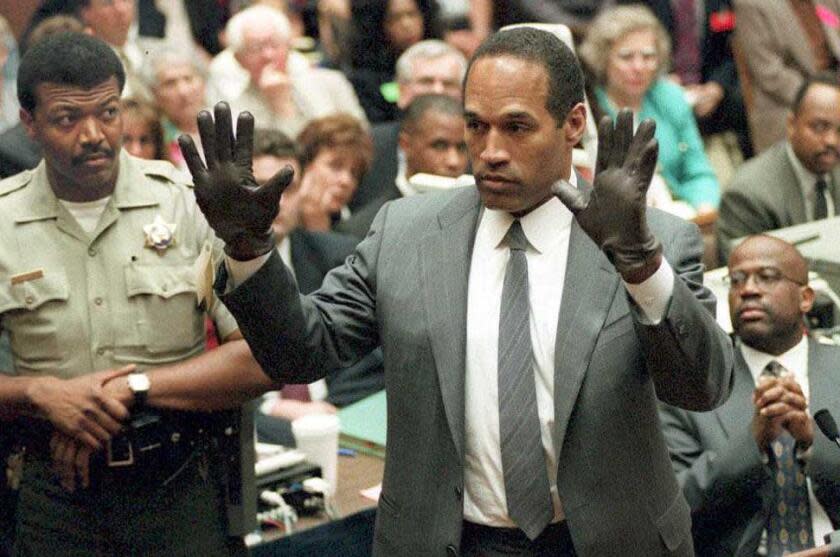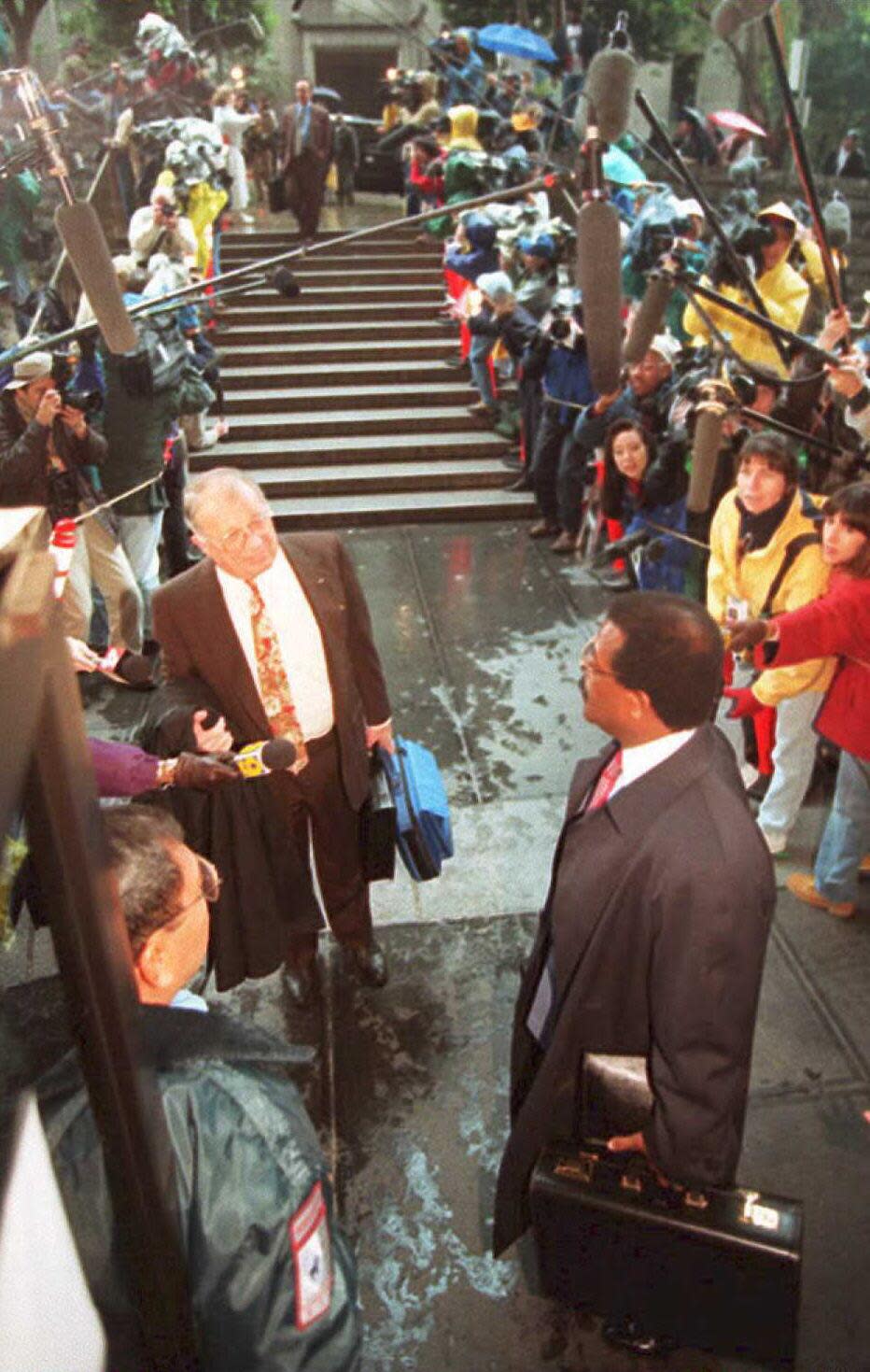How O.J. Simpson's murder trial changed the TV news business

The double-murder case against football star and actor O.J. Simpson, who died of cancer Thursday at age 76, forever transformed the TV landscape.
Network news was still a buttoned-down institution in 1994, when more than 30 million viewers were tuning into the evening newscasts each night. The anchors of the time — Tom Brokaw on NBC, Peter Jennings on ABC and Dan Rather on CBS — were powerful arbiters of what the public needed to know.
The internet was nascent and CNN, available in about half the country on cable, was considered a tier below the Big Three networks.
But the landscape changed on June 17, 1994, the day of the wild slow-speed police chase on the freeways of Los Angeles of Simpson in his white Bronco, two days after the brutal slayings of his ex-wife Nicole Brown Simpson and her friend Ron Goldman.
A reported 95 million people watched Simpson flee capture. Airing across all three networks, local stations and CNN, the chase became a defining "where were you" TV moment on par with the Kennedy assassination in 1963 or the explosion of the space shuttle Challenger in 1986.
NBC's feed of the chase was presented simultaneously alongside coverage of the NBA Finals game between the Houston Rockets and the New York Knicks, making for one of the most bizarre split screens in the history of the medium.
From that moment forward, the country became transfixed with every aspect of the case, from Simpson's arraignment to the stunning acquittal that made him a free man again on Oct. 3, 1995. An estimated audience of 150 million watched it live.
Network news traditionalists were reluctant to give the Simpson story major coverage at first. But viewer interest in the case made it impossible to ignore.
"It showed the importance of following the audience instead of the anchor telling you what was important," said Tammy Haddad, a veteran news producer who currently heads the Washington AI Network, a forum for Beltway types to discuss artificial intelligence. "That’s a major sea change."
Bill Whitaker, who covered the story for "CBS Evening News," remembered the ambivalence at serious news organizations.

"There was a love-hate relationship with the story because it took on the air of a soap opera," said Whitaker, now a correspondent for the CBS News magazine "60 Minutes," in an interview. "But it was unavoidable. As a news organization you had to cover it."
"It had race. It had sex. It had drugs. A sports hero turned movie star. Every ingredient that would capture people's attention."
Jennings, a Canadian whose specialty was international affairs, was particularly dismissive of the story's tabloid nature.
But Brokaw, who'd been an anchor at KNBC in Los Angeles when Simpson emerged as a star running back at USC in the late 1960s, understood its significance and led with the case every night. His "NBC Nightly News" broadcast surged to No. 1 in the ratings as a result, topping "ABC World News Tonight," which had held the lead for years.
"It came at that perfect time to merge celebrity news, traditional news and court news," said Steve Friedman, who was executive producer of NBC's "Today" at the time. "The traditional news people didn’t understand the gravity of the storyline. You could not take your eyes off it. People of my generation said, 'You must cover it.'"
The downside, as Whitaker saw it, was that the lines between serious newscasts and more tabloid-style outlets and entertainment-driven programs became blurred. "It changed the media landscape," he said. "In the mind of the TV viewer, it put all of us in the same basket."
Read more:How the Menendez brothers case blazed a trail for the true crime genre
The old-guard news divisions had little choice but to cover the story as cable networks were giving it to viewers around the clock.
A few years earlier, CNN and Court TV had already seen a surge in viewership during their gavel-to-gavel coverage of the first Menendez brothers trials for the murder of their parents. Before that, the rape trial of William Kennedy Smith captivated audiences. Cameras in the courtroom gave the outlets inexpensive hours of live coverage they could package into a continuing saga that kept viewers hooked.
Those cases showed the appetite for true-crime stories. But the Simpson trial became the genre's first megahit.
For nearly a year, Whitaker was stationed outside the courthouse in downtown Los Angeles, delivering reports every night atop a rickety six-story scaffold to get a view among the throngs of media crews surrounding the area every day.
More than once, Whitaker would prepare a story in the morning, only to scrap it by afternoon because there was another shocking new development. "I had never been in a trial where just about every day there was a moment where you gasped," he recalled. "Police Det. Mark Fuhrman’s racial slurs. The glove not fitting."
Even the technical aspects of the case kept viewers glued.
"Every day was a big news day," said Dan Abrams, a longtime legal analyst who hosts a nightly program on cable network NewsNation. "A DNA expert is testifying today about scientific evidence and the public is still riveted. We'd never seen anything like a nine-month event when every day there was a revelation the public was following."
The sustained around-the-clock coverage of the trial created TV stars out of participants. Whitaker recalls defense attorney Johnnie Cochran being asked for autographs outside the courthouse. Abrams remembers vendors selling hats with the names of the lawyers in the case affixed to them.
"No rock star or president had the kind of recognition Johnnie Cochran had at that time," Abrams said.
Cochran and prosecuting attorneys Marcia Clark and Christopher Darden all landed TV jobs after the trial. Even Fuhrman became a cable news contributor and still shows up on TV to weigh in on cases.
Journalists and commentators who covered the case saw their careers skyrocket. Court TV became a feeder to larger outlets. Greta Van Susteren, went from lawyer and legal commentator to anchor on several cable networks.
Abrams left a law firm job to become an associate producer at Court TV and was promoted to reporter just before the Simpson case heated up. It ended up making him a TV news fixture. He still feels conflicted about the tragic circumstances that set him up for a success.
"It was the first big story I ever covered," Abrams said. "I always had a little bit of guilt over the idea that two people brutally murdered helped make my career."
"Then again, when you cover legal stories you're covering a lot of murders," he added. "My focus was a lot on the legal points. But I went out of my way to get to know the victims' families very well. To look at it without their perspective would have been extremely callous."
This story originally appeared in Los Angeles Times.
